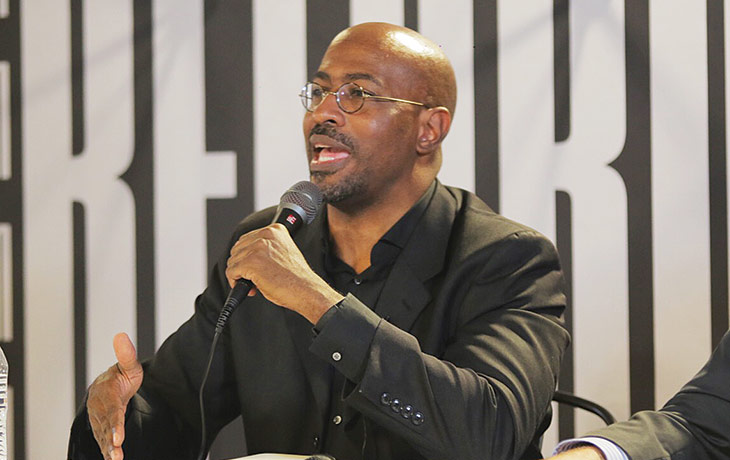Last month, CNN contributor Van Jones appeared on HBO’s Real Time with Bill Maher and discussed the murder rates of young Black males across the United States.
Maher remarked, “We do know that, for young Black men, gun homicides are the leading cause of death. And … that leading cause outstrips the next 15 causes combined … Also, Black men ages 18 to 25 die from gun homicides at a rate nearly 19 times that of White young men of the same age. And they’re not being killed by White supremacists; they’re being killed by each other; that is the truth.”
Jones concurred and then told Maher, “I’m really glad that you raised it because I think there is this myth that the Black community only cares about a Black kid getting killed if a White cop does it or a White supremacist does it, and it’s just not true. The media only cares.”
Jones insinuated that the media purposefully ignores the leading cause of death among Black males because it prioritizes news about White males shooting and killing Black men. Right-wing media outlets instantly applauded Jones for pointing out how the mainstream media “only cares” about “fanning the flames of racial division.”
However, Jones and Maher were talking about the reality of “Black-on-Black crime.”
They avoided the term because, for the past 15 years, Black intellectuals have been campaigning to eradicate the phrase “Black-on-Black crime” from the national discourse. These Black thinkers successfully persuaded the public that “Black-on-Black crime” was a myth.
How did this happen? Let us start from the beginning.
A Chicago Daily Defender reporter covering the 1968 riots first used the term “Black-on-Black.” The reporter stated that when stabbings, muggings, and rapes were “Black-on-Black,” they were “canceled out in the mind of a White precinct commander.” So, the police would not waste time or money on Black victims.
That means that the term “Black-on-Black crime” was originally associated with the neglect of Black victims. Jones criticized the mainstream media for this very reason, but that’s not why the media isn’t covering it. Jones forgot that the term “Black-on-Black crime” had been redefined.
In 2005, Professor David Wilson published Inventing Black-on-Black Violence. During the 1970s, Black communities demanded that police departments devote as much time and resources to victims of “Black-on-Black crime” as they did to their White counterparts. Wilson said that these well-intentioned Black folks introduced the term to the political establishment. Eventually, the Reagan administration used the term “Black-on-Black” to imply that Blacks were responsible for their own problems. Wilson argued that when Republicans used the term, it normalized the idea that Black culture fostered criminality.
Wilson stated, “There was no reason to racialize this. It could have been framed as an economic or social-driven crime—why not call it ‘oppressed youth-on-oppressed youth’ or ‘disenfranchised-on-disenfranchised’ crime?”
Here, Wilson attempted to remove any stigma from Black culture by labeling the phenomenon based on the systemic and structural issues that contributed to violence in predominantly Black areas. Obviously, Wilson was more concerned with destigmatizing Black culture than with the actual victims of violence.
Five years later, Khalil Gibran Muhammad published The Condemnation of Blackness: Race, Crime, and the Making of Modern Urban America. Gibran explained that in the nineteenth century, White social scientists manipulated arrest and jail records to equate blackness with crime.
In the 21st century, terms like “Black-on-Black crime” reinforced that racist correlation, and Black intellectuals became more concerned with eradicating the correlation than with addressing the phenomenon that results in a massive imbalance in Black victims and unsolved killings.
In 2013, Jemelle Bouie remarked, “There is no such thing as Black-on-Black crime. Yes, from 1976 to 2005, 94 percent of Black victims were killed by Black offenders, but that racial exclusivity was true for White victims of violent crime—86 percent were killed by White offenders.” In other words, if the victims of White criminals are largely White, it is natural for the victims of Black criminals to be predominantly Black, and since there is no such thing as “White-on-White crime,” there should not be a term like “Black-on-Black crime.”
A year later, sociologist Gary Younge reiterated this idea, writing, “Far from being extraordinary, the fact that Black criminals are most likely to commit crimes against Black people makes them just like everyone else. A more honest term than “Black-on-Black crime” would be simply “crime.”
In 2014, Black Lives Matter rose to national prominence by protesting the police shooting of an unarmed Black teenager in Ferguson, Missouri. However, many conservative commentators questioned why Black Lives Matter was not attempting to prevent “Black-on-Black crime.”
In response to those inquiries, a 2014 Media Matters headline read: Right-wing media push “Black-on-Black” crime canard to distract from Ferguson police shooting. From that moment forward, the term “Black-on-Black crime” was regarded as a racist “dog whistle” used by the right to associate blackness with criminality.
In 2017, freelance writer Sa’iyda Shabazz stated, “Black-on-Black crime is a myth. That’s right—it was invented by White people to make Black people look like dangerous hoodlums and killing machines. This way, it keeps the ghettos full of low-income Black people [and] keeps them incarcerated at disproportionately high rates.”
Shabazz believes the term helped lead to mass incarceration.
The mainstream media does not ignore the carnage in Black communities, as Van Jones suggested; they simply do not want to offend their Black audience or be accused of blowing a racist “dog whistle” by publicizing it.
